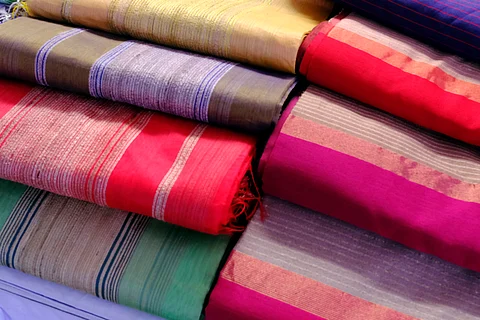

ISTOCK
Imagine standing in a busy market surrounded by the most colourful fabrics you’ve ever seen—silks that shimmer like rainbows, soft cottons with patterns that twist and curl, and scarves so light they could almost float away. Chances are, many of these were made on a handloom, a special kind of weaving tool that has shaped India’s story for centuries. Every year on 7th August, India celebrates National Handloom Day, a time to recognise the beauty and importance of these woven wonders and the people who create them.
The story of Indian handlooms goes back thousands of years—so far, in fact, that pieces of handwoven cloth have been found in the ruins of ancient cities like Mohenjo-daro and Harappa. Long before machines and factories, people in villages all over the country used handlooms to make cloth for everyday use and for special occasions. Each region developed its own unique style. From the bright Ikats of Odisha and Telangana, to the fine Jamdanis of Bengal and the elegant Chanderis of Madhya Pradesh, handlooms became a way for communities to tell their stories through patterns and colour.
But what exactly is a handloom? If you could peek inside a weaver’s home or workshop, you’d see a simple but clever wooden frame, with threads stretched tightly across it. The weaver moves the shuttle back and forth, slowly building up the cloth, row by row. Every movement is guided by hand, so no two pieces of handloom fabric are ever exactly alike. It takes skill, patience, and sometimes days or even weeks to finish a single sari, dupatta, or shawl. While the process might look old-fashioned, handloom weaving is actually an art form—and one that requires real science and mathematics to get the patterns and designs just right.
Handlooms aren’t just about fabric—they’re about families, traditions, and culture. In many Indian villages, weaving is a family affair. Grandparents, parents, and children all play a part, passing down secrets and techniques from one generation to the next. Sometimes, patterns or motifs have special meanings: a peacock might stand for beauty, a lotus for purity, or a temple border for blessing and protection. Every region, every family, and sometimes even every weaver brings their own touch to the fabric they create.
Handloom weaving also played a huge role in India’s freedom movement. When Mahatma Gandhi encouraged people to spin their own yarn and wear khadi, a type of handspun cotton, it wasn’t just about making clothes. It was a way to resist British rule and show pride in Indian skills and self-reliance. The spinning wheel, or charkha, became a powerful symbol of the struggle for independence. Even today, when you see the charkha on the Indian flag, it’s a reminder of how something as simple as making cloth can change the course of history.
Of course, the world has changed a lot since those days. Today, there are big factories that can produce fabric much faster and more cheaply than a handloom ever could. But that’s exactly why handloom weaving is so special. Each piece takes time and care. No machine can match the tiny variations in colour and texture, or the sense of connection you get when you know your scarf or shirt was woven by someone’s hands, not by a robot. Many designers and fashion lovers now celebrate handloom fabrics for their uniqueness, comfort, and eco-friendliness. Unlike synthetic materials, handloom cloth is often made with natural dyes and fibres, which are better for the environment and for your skin.
National Handloom Day was first celebrated in 2015, chosen because on 7th August 1905, the Swadeshi Movement was launched in Calcutta (now Kolkata) to promote Indian-made goods and boycott foreign products. Today, the day is marked by fairs, exhibitions, and fashion shows across India, shining a spotlight on the incredible talent of weavers from every corner of the country. Social media fills up with stories and photos of people wearing handloom clothes, sharing why these fabrics matter and how buying them can support local communities.
When you next wear a handloom kurta, sari, or dupatta, think about the journey it’s taken—from fields where cotton or silk was grown, to the skilled hands that spun the threads, and finally to the weaver who brought it all together on a simple wooden loom. Each piece is a living piece of art, carrying the hopes, dreams, and stories of the people who made it.
Handlooms remind us that some things are worth waiting for and cherishing. In a world that moves at lightning speed, it’s amazing to know that a process so old and simple can still make something beautiful and new. On National Handloom Day, take a moment to celebrate the threads that tie us all together—the skill, creativity, and heritage of India’s weavers, and the colourful handloom fabrics that have travelled from tiny villages to fashion runways and wardrobes all over the world.
Millions of weavers across India still make fabrics by hand, more than any other country on Earth.
From Banarasi silks in Uttar Pradesh to Pochampally Ikat in Telangana and Assam’s Muga silk, every part of India has unique designs and weaving traditions.
Mahatma Gandhi promoted khadi, a handspun fabric, as a symbol of self-reliance and resistance against British rule.
Intricate sarees like the Kanjeevaram or Patola can take weeks or even months to complete—one thread at a time!
Many handloom fabrics use dyes from plants, flowers, and even fruits, making them better for the environment.
Because they’re made by hand, every piece is unique—even if the pattern looks similar.
ISTOCK
In many weaving communities, skills and secrets are passed down from parents to children for generations.